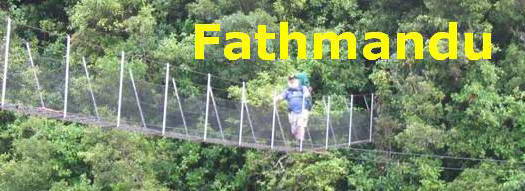
Many thanks for permission to use graphics from their software and toposheets |
 |
|
20 May 2007 Ian Wells Trackformerly Auxiliary Dam Track, or Upper Nihotupu Track page 4
Here is the more typical Pseudopanax leaf form, leathery and hard. The white moss on the banks stands out strongly against the typically darker backgrounds
Here's another leathery leaf - an Olearia, I think,but I'm not good enough on this genus to guarantee getting them sorted properly.
And here's another scrub species, preferring the harsher, drier ridges: Gleichenia microphylla.
Probably birds, possibly pigs. I've seen other areas in the Waitaks even more dug over.
Boggy bits.
A young karamu.
And more comfortable, easy going.
Herte's a tree I haven't seen before, or haven't known that I've seen. Thanks to Tony Foster of Bushman's Friend for the identification: Tawari, Ixerba brexioides. I'm looking forward to catching this one in flower - it has one of the most striking flowers to be found in the bush. It's also an example of the somewhat quirky humour found occasionally in rarefied scientific circles. Ixerba is an anagram of Brexia, which it resembles (hence brexioides) Around here I start thinking about gumboots, or even waders.
Ther bush is becoming a little more substantial.
Here a substantial punga dominates the track for a short distance
A young totara leans out from the side of the path.
Here's the second stream crossing of consequence. This one I didn't even try to leap over, I just selected the shallowest bit and waded through. Wet boots. I don't mind wet boots. They're comfortable to walk in and soon warm up. However, if you've got them on, warm and wet, for several hours and you haven't been carefully treating them with Gran's Remedy in between walks, you wind up as I did with every crack in your feet covered in fungal infections and painful as hell. I treat it with Resolve antifungal liquid and rub Rawleighs ointment into the soles of my feet to protect the new skin. Works like a charm but better if you don't get infected in the first place.
The track continues beside the stream
and cross a small tributary stream and suddenly in front of us is a large red circle. I am nothing if not a traditionalist, and I expect orange triangles to mark the track, not bloody great red traffic lights which for all I know could be some kind of arcane warning system I am not familiar with.
I think these are crown ferns, but there are a number of fairly similar species, and I won't push it.
The bush is now much grander and darker, and is encroaching somewhat on the track.
Alice is fascinated by the stream and heads down for a closer look.
This bit requires a bit of care.
A little further along is the third stream crossing, no big deal at all, but might be after heavy rain. This stream looks as if it's equipped to handle much larger volumes.
Now, where's that track got to.
Ah. There's another red circle way over there.
About here we start some serious climbing. Well, as serious as this track gets which is not very. It's still a touch slippery underfoot though.
We've changed dramatically from the low scrub of the first half of the track.
The moss is quite spectacular. The track is getting a touch more demanding.
A wonderful specimen of umbrella fern.
We're starting to level out about now.
This is a lovely example of an old punga stump serving as a plant pot.
Nice, easy and dry walking again.
Hmmm. The Cutty Grass Track is up ahead somewhere and this is cutty grass. I wonder....
and that's looking lighter ahead, too.
Yup. We're here. Coffee time and a sandwich and a dish full of water for Alice, though she probably got all she needed at the stream crossing.
On the trip back, striding out a bit and not stopping for photographs, I make it in just over the hour. Fatman time here is closer to a couple of hours.
Back at the van. That was a good stretch, especially on the homeward trek.
|
|